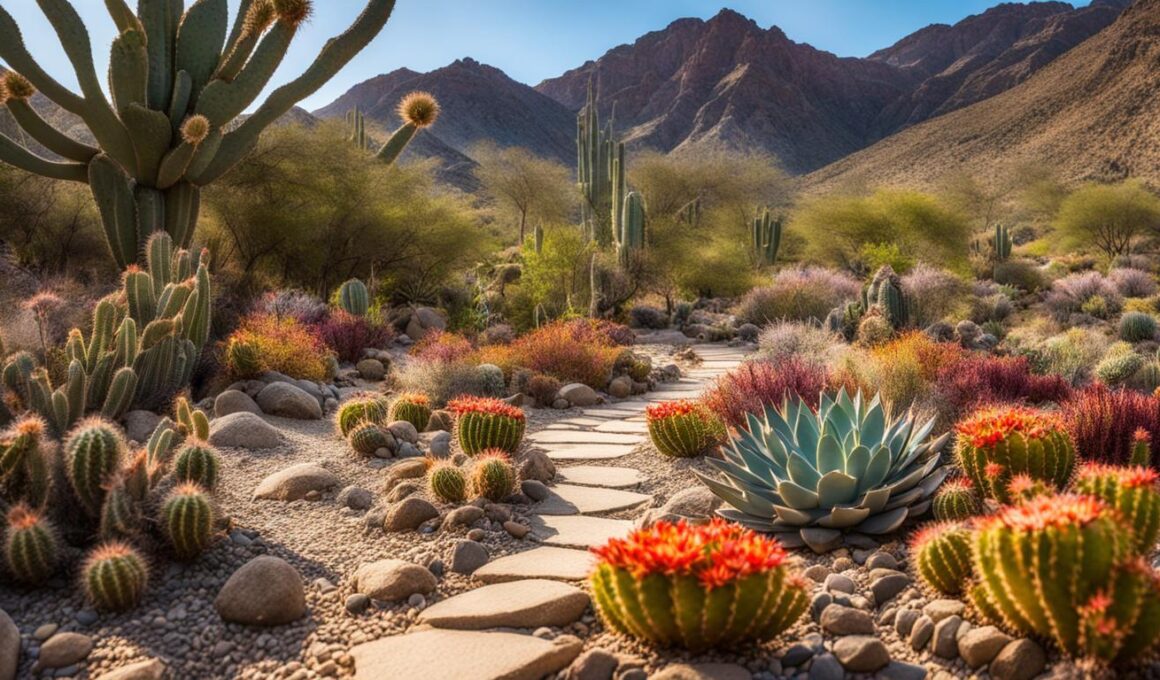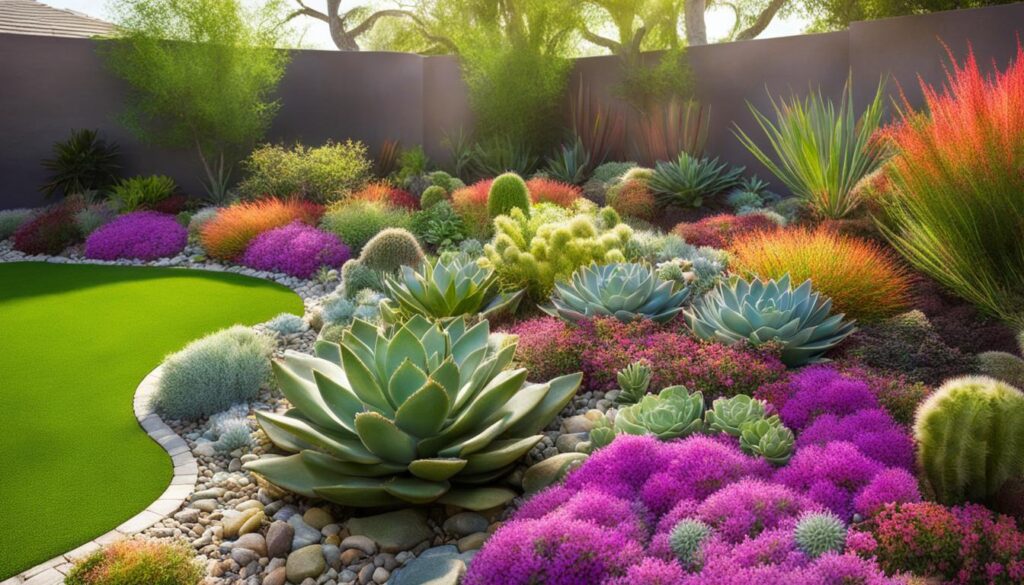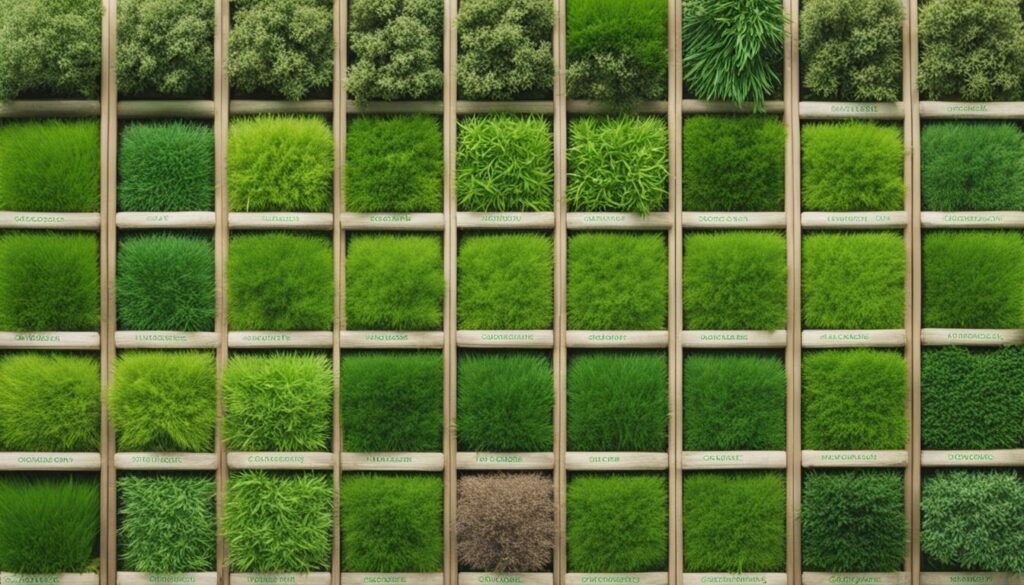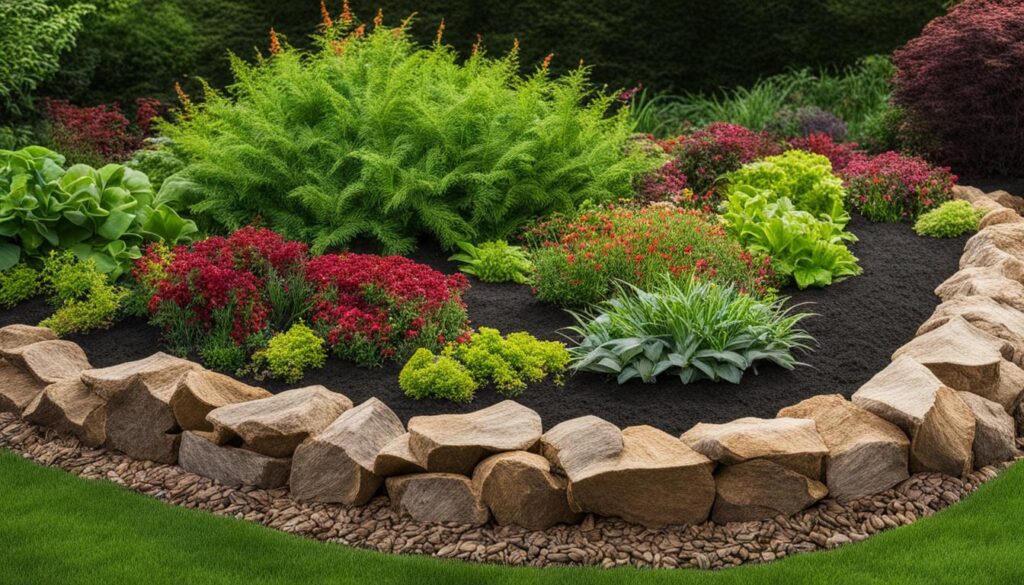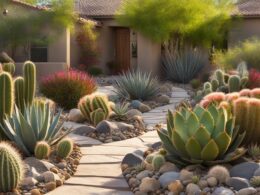Are you tired of high water bills and wasting precious resources on your garden? It’s time to embrace xeriscaping, an eco-friendly gardening technique that can significantly reduce your garden’s water usage. With xeriscaping, you can create a lush and vibrant outdoor space while conserving water and saving money. Let’s explore the key principles of xeriscaping and how you can implement them in your garden.
Key Takeaways:
- Xeriscaping is an effective way to reduce water usage in gardens and lower water bills.
- It involves planning, soil analysis, plant selection, use of mulches, and proper maintenance.
- Xeriscape gardens offer benefits beyond water conservation, including low maintenance and promoting a healthy ecosystem.
- Choosing water-efficient turf, using soaker hoses, and implementing proper maintenance practices are essential for successful xeriscaping.
- By embracing xeriscaping, you can create a sustainable and beautiful outdoor space that contributes to water conservation efforts.
The Benefits of Xeriscape Gardens: Beyond Water Conservation
Xeriscape gardens are more than just an environmentally friendly way to conserve water. In addition to their water-saving capabilities, these gardens offer a range of benefits that make them an attractive option for homeowners. One of the key advantages of xeriscape gardens is their low maintenance requirements. Unlike traditional gardens, which often demand frequent mowing, mulching, and watering, xeriscape gardens require minimal effort to maintain. This not only saves you time and energy but also reduces the need for costly maintenance tasks.
Furthermore, xeriscape gardens promote a healthy ecosystem by providing support for wildlife and increasing biodiversity. By incorporating native plants into your xeriscape design, you can create a habitat that attracts birds, butterflies, and other beneficial insects. This not only contributes to the overall health of the environment but also adds a touch of natural beauty to your outdoor space.
Another benefit of xeriscaping is the positive impact it has on the health of your soil. Through the use of organic mulches, xeriscape gardens increase the organic matter in the soil, improving its water absorption capacity. This means that your plants will receive the moisture they need more efficiently, reducing the amount of water required. Additionally, the mulch helps to control weeds, further reducing the maintenance needed to keep your garden looking its best.
Key Benefits of Xeriscape Gardens:
- Water-saving capabilities
- Low maintenance requirements
- Supports wildlife and increases biodiversity
- Improves soil health and water absorption
- Reduces weed growth
Overall, xeriscape gardens offer a multitude of benefits beyond water conservation. They are visually appealing, require less maintenance, support wildlife, and promote healthier soil. By embracing xeriscaping techniques, you can create an eco-friendly and beautiful outdoor space that enhances both the aesthetics and sustainability of your home.
Xeriscaping Planning and Design: Creating a Water-Efficient Landscape
When it comes to xeriscaping, careful planning and design are essential for creating a water-efficient landscape that thrives in your local climate. By considering factors such as native plants, water needs, and soil analysis, you can design an eco-friendly garden that not only conserves water but also enhances the beauty of your outdoor space.
One of the key steps in xeriscaping is selecting the right plants based on their water needs and suitability to your region. Native plants, which are adapted to the local climate, generally require less water and are more resilient in challenging conditions. By incorporating native plants into your design, you can reduce water usage while promoting biodiversity and supporting local wildlife.
Before planting, it is crucial to conduct a soil analysis to assess its organic content and water retention capacity. This analysis helps you determine the soil’s ability to absorb water and retain moisture, which is essential for healthy plant growth. You can enhance the water absorption capacity of the soil by increasing its organic matter through the addition of compost or organic amendments.
Determining Water Needs and Maximizing Efficiency
To ensure efficient water usage in your xeriscape garden, it is important to consider the water needs of individual plants and group them accordingly. This allows for better irrigation planning and prevents overwatering or underwatering. Creating separate irrigation zones for plants with similar water requirements ensures that each plant receives the right amount of water, minimizing waste.
Additionally, incorporating efficient watering techniques such as drip irrigation or soaker hoses can further reduce water consumption. These methods deliver water directly to the plant’s root zone, minimizing evaporation and runoff. By maximizing water efficiency through proper planning and design, you can create a sustainable and visually appealing xeriscape garden.
Turf Selection: Choosing Water-Efficient Options
When it comes to xeriscaping, one of the key considerations is turf selection. By choosing water-efficient options, you can significantly reduce the amount of water needed to maintain your garden. In Oklahoma, two popular choices for turf are Fescue and Bermuda grass.
While both Fescue and Bermuda grass can thrive in this region, it’s worth noting that Fescue requires twice as much water in the summer compared to Bermuda grass. If water conservation is a priority for you, opting for Bermuda grass can help lower your overall water usage without sacrificing the greenery in your garden.
However, if you’re looking for even more water reduction, there are other turf options to consider. Zoysia and buffalo grass are both known for their low water needs, making them ideal choices for xeriscaping. By selecting these water-efficient turfs, you can conserve water and still enjoy a lush and vibrant garden.
Benefits of Water-Efficient Turf Selection
- Reduced Water Usage: Choosing water-efficient turf varieties can significantly lower your water bills and conserve valuable water resources.
- Environmental Impact: By reducing water consumption, you contribute to water conservation efforts and promote sustainable gardening practices.
- Lower Maintenance: Water-efficient turfs often require less maintenance, including watering, mowing, and fertilizing. This can save you time and effort in maintaining your garden.
- Drought Tolerance: Water-efficient turfs are better equipped to withstand periods of drought, ensuring your garden remains green and healthy even during dry spells.
By carefully considering your turf selection and opting for water-efficient options like Bermuda grass, Zoysia, or buffalo grass, you can create a beautiful xeriscape garden that not only conserves water but also enhances the overall sustainability of your outdoor space.
Mulches: Enhancing Water Retention and Weed Control
In xeriscaping practices, the use of mulches is essential for creating a water-efficient and low-maintenance garden. Mulches play a crucial role in enhancing water retention in the soil, reducing the need for frequent watering. By applying a thick layer of mulch, you can lock in moisture and create a barrier against evaporation, ensuring that your plants receive adequate hydration even in hot and dry conditions.
Mulches also help control weeds, which can compete with your plants for water and nutrients. By blocking sunlight and inhibiting weed germination, mulches act as a natural weed suppressant, reducing the need for chemical herbicides and manual weeding. This saves you time and effort while keeping your garden space clean and weed-free.
“Applying a thick layer of mulch in your xeriscape garden is like giving your plants a protective blanket. It helps retain moisture, keeps the soil cool, and prevents weed growth.” – Gardening expert
Additionally, mulches serve as a natural insulator, regulating soil temperature and protecting the roots of your plants from extreme heat or cold. This is especially beneficial for delicate or shallow-rooted plants that are more susceptible to temperature fluctuations. By maintaining a stable soil temperature, mulches create a favorable environment for healthy plant growth.
Types of Mulches:
- Organic mulches, such as wood chips, straw, or shredded leaves, break down over time, enriching the soil with organic matter and nutrients.
- Inorganic mulches, such as gravel or rocks, provide a long-lasting option that does not decompose but still helps with moisture retention and weed control.
- Living mulches, such as low-growing groundcovers or creeping plants, offer a dynamic option that adds aesthetic appeal while serving the same functions as traditional mulches.
By incorporating the right mulches into your xeriscape garden, you can significantly enhance water retention, control weeds, and create a visually appealing and sustainable outdoor space.
Efficient Irrigation: Soaker Hoses for Water Reduction
Efficient irrigation plays a crucial role in reducing water usage in xeriscaping. One effective tool to achieve this is the use of soaker hoses. Soaker hoses are specially designed to allow water to seep slowly into the soil, directly targeting the root zone of plants. By delivering water directly to the roots, soaker hoses minimize water loss through evaporation and runoff, making them highly efficient in water usage reduction.
Soaker hoses work by releasing water along their entire length, dripping water through tiny pores in the hose itself. This low-pressure irrigation method ensures that water is delivered precisely where it is needed, reducing waste and maximizing plant uptake. With soaker hoses, you can effectively water your xeriscape garden while minimizing water usage and promoting healthier plant growth.
Advantages of Soaker Hoses:
- Water efficiency: Soaker hoses deliver water directly to the root zone, minimizing water loss through evaporation and runoff.
- Precise irrigation: The slow, steady flow of water from soaker hoses ensures that plants receive adequate moisture without oversaturation.
- Reduced weed growth: By watering at the root level, soaker hoses help prevent weed growth by minimizing water availability on the soil surface.
- Cost-effective: Soaker hoses are an affordable and durable option for efficient irrigation, saving you money on water bills.
- Easy installation: Soaker hoses are easy to install and can be customized to fit the specific needs of your xeriscape garden.
When using soaker hoses, it is important to consider the water needs of different plants in your xeriscape garden. Group plants with similar water requirements together, allowing you to tailor the watering schedule to their specific needs. Additionally, regularly inspect your soaker hoses for any leaks or clogs to ensure optimal water distribution.
By incorporating soaker hoses into your xeriscape garden, you can efficiently irrigate your plants while reducing water usage. Soaker hoses provide targeted watering, minimize water loss, and promote the overall success of your water-saving efforts.
How Can Xeriscaping Benefit Water Conservation in Gardens?
Xeriscaping, a form of smart gardening for water conservation, offers multiple benefits for gardens. By using drought-resistant plants and efficient irrigation systems, xeriscaping reduces water usage significantly. This sustainable landscaping approach not only saves water but also promotes healthier soil and reduces maintenance needs.
Maintenance Tips for a Successful Xeriscape Garden
Maintaining a xeriscape garden is relatively easy and requires less effort compared to traditional gardens. By following a few simple maintenance tips, you can ensure that your xeriscape garden remains vibrant, water-efficient, and low maintenance for years to come.
Watering
Proper watering is crucial for the health and vitality of your xeriscape garden. While xeriscape gardens are designed to be water-efficient, it’s important to provide adequate moisture to your plants, especially during the establishment period. Water deeply but infrequently to encourage deep root growth and drought tolerance. Consider using drip irrigation or soaker hoses to deliver water directly to the roots, minimizing evaporation and runoff. Monitor the moisture levels in the soil and adjust your watering schedule accordingly, avoiding overwatering.
Mulching
Mulching is a key practice in xeriscaping that helps conserve water, control weeds, and regulate soil temperature. Apply a layer of organic mulch, such as wood chips or bark, around your plants to reduce evaporation, retain moisture in the soil, and suppress weed growth. Mulch also acts as an insulating layer, protecting the roots from extreme temperatures. Ensure that the mulch layer is around 2-3 inches thick and avoid piling it against the stems of your plants, as this can lead to rot.
Reduced Maintenance
One of the main advantages of xeriscape gardens is reduced maintenance. By selecting drought-tolerant, native plants, you can minimize the need for pruning, fertilizing, and pest control. Native plants are well-adapted to your local climate and soil conditions, requiring less attention and resources. Additionally, the use of mulches and efficient watering methods significantly reduces the frequency of mowing, weeding, and other time-consuming tasks. With proper planning and design, a xeriscape garden can be a beautiful and low-maintenance oasis.
Conclusion
Xeriscaping provides a sustainable solution for reducing garden water usage and promoting eco-friendly gardening practices. By implementing the seven steps of xeriscaping, you can create a beautiful outdoor space while significantly conserving water resources and reducing water bills. With careful planning, appropriate plant selection, efficient irrigation, and proper maintenance, you can create a thriving xeriscape garden that requires minimal water.
Embracing xeriscaping not only helps you create a visually appealing garden but also plays a crucial role in water conservation efforts. By reducing your garden’s water needs, you contribute to the preservation of this precious resource. Xeriscaping also promotes sustainable gardening practices by encouraging the use of native plants, mulching, and efficient irrigation systems like soaker hoses.
As you embrace xeriscaping, you join the movement towards a more sustainable future. By implementing these techniques, you can not only reduce your environmental impact but also enjoy the benefits of a low-maintenance garden. So, start your xeriscape journey today and make a positive difference in your garden water usage while creating a beautiful and sustainable outdoor space.





